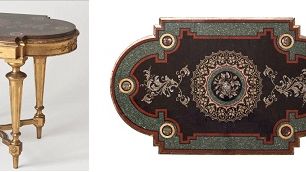
Press release -
New acquisition: Drawing-room table with porphyry mosaic top
Nationalmuseum has added a table with a porphyry mosaic top to its applied art and design collection. The tabletop was produced by Elfdals Porphyrverk around 1860. The table, an important addition to the museum’s collection of 19th-century Swedish furniture, is on display on Level 1 of the museum.
Last spring, Nationalmuseum acquired what is thought to be a unique Swedish table with a porphyry mosaic top. The tabletop shows neo-rococo influences in its form and decoration, which dates it to around 1860, four years after the Swedish royal family sold Elfdals Porphyrverk to Erik Gideon Arborelius. Arborelius ran the business until his death in 1866, and the factory burned down the following year, ending the production of large pieces in Swedish porphyry.
Porphyry is a very hard material that is difficult to work with. Most previously known porphyry mosaic tabletops are part of the Swedish royal collections and feature a variety of geometric patterns. The recently acquired table features naturalistic depictions of flowers and leaves, created using tiny square and rectangular pieces of multicoloured porphyry. To modern eyes, these produce a “pixelated” image, whereas 19th-century observers would have likely compared the effect to a cross-stitch embroidery.
The table was probably produced as a custom order or an exhibition piece. The only similar piece previously known is a smaller round stone tabletop with the same rose pattern as the centre medallion of this table. Nationalmuseum’s collections contain very few Swedish artifacts from this period, which was greatly disparaged by the modernist art establishment in the 20th century. The table has been purchased with funds donated by the Sara and Johan Graumann Foundation. It is currently on display in Nationalmuseum’s applied art and design section.
Further information
Anders Bengtsson, curator applied art and modern design
anders.bengtsson@nationalmuseum.se, +46 8 5195 4385
Hanna Tottmar, press officer
hanna.tottmar@nationalmuseum.se, +46 8 5195 4390
Press images: www.nationalmuseum.se/pressroom
Categories

